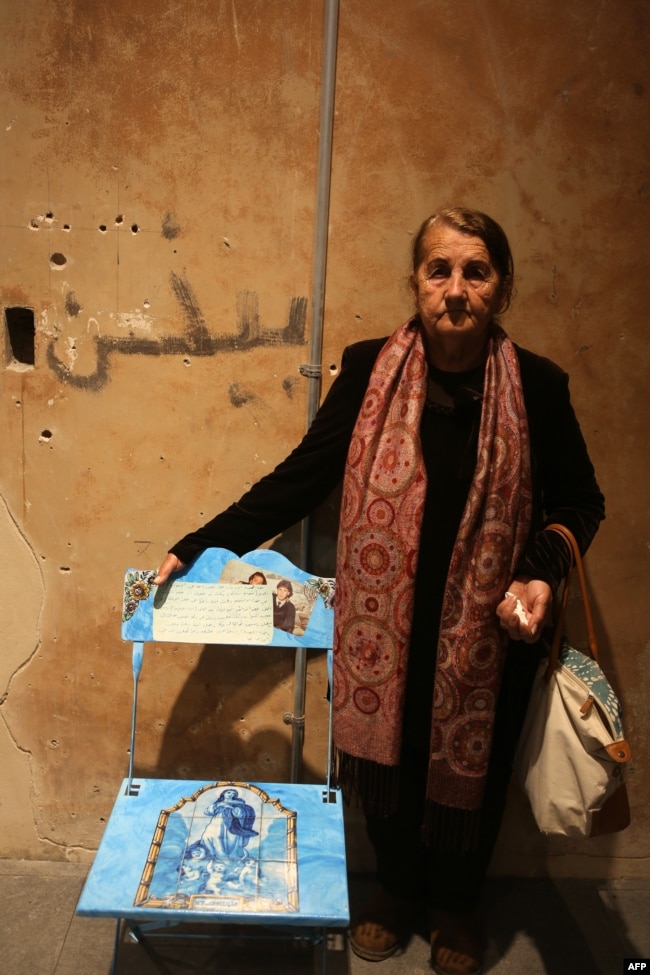
missing during the Lebanese civil war, as she stands next to an empty
chair during an exhibit in Beirut, April 13, 2017.
The Lebanese government was urged on Thursday — the 42nd anniversary
of the start of the nation’s civil war — to help families of the
thousands of missing by approving a project to collect DNA samples to
try to trace their whereabouts. With families still struggling to cope with their loss, the
International Committee of the Red Cross (ICRC) and non-government
organization Act for the Disappeared staged a one-day exhibition in
Beirut of chairs made by families of the missing.
“People who have lost a member of their family and don’t know what
happened are living in this in between,” Fabrizio Carboni, head of the
ICRC delegation in Lebanon, told Reuters. “No grief possible and at the
very same time hope is still present. So, it is really torture for these
families.” More than two dozen families participated in “Empty Chairs, Waiting
Families,” an exhibition of chairs painted with drawings and pasted with
photos. The ICRC called on Lebanese authorities to run a project to collect
DNA samples, and to pass a law that will help families of the missing
get clarity on what happened to them.There is currently no public database or exact numbers for people who
went missing during the civil war between 1975-1990, in which an
estimated 150,000 people were killed.

Nohad stands next to an empty chair decorated with a
painting of the Virgin Mary and angels, and bearing the portrait of her
son Ayman, a Lebanese man who went missing during the Lebanese civil
war, during an exhibit in Beirut, April 13, 2017.
Lebanon was shattered by its 15-year-long war. Villages and
neighborhoods in which Muslims and Christians had lived side by side for
centuries were reshaped. Hundreds of thousands of people retreated into
separate enclaves controlled by sectarian militias.
Fate unknown
The ICRC said thousands of people from all sides and backgrounds went
missing during the civil war and their fate remains unknown.
“Under international humanitarian law, government authorities are
required to clarify the fate of persons who go missing in conflict
situations. However, Lebanon has yet to take the necessary steps,” the
ICRC said in a statement.
The ICRC is asking the state to set up a mechanism to give families
some answers — whether that is through preserving and opening mass
graves, or getting forensic information or biological reference samples.
Missing since 1982 was Said, whose 80-year-old brother Riad Sharif
Harmouch used his chair to draw his brother in the car he used to
transport people between the Christian East and Muslim West of Beirut,
returning them to families if they went missing.
“I am two years older than my brother. I was really affected. We were
really close friends, more than just brothers. I lost a piece of me,”
said Harmouch.
Fardous and her mother, Jamila Agha, drew her father Nazih’s fishing
boat and motorcycle on a chair. He used to fish and sell what he caught
while riding his motorcycle.
“We have hope that he will come back so we can get back what was
taken away from us,” said Fardous, whose father went missing in 1982
when she was two years old.
Sayde Jhantous Tayyar, 53, whose brother Elias has been missing since
1984, replicated part of a drawing her brother did when he was younger
on a chair and drew him holding a kite.
Jebran Harmouch, 71, whose brother Elias has been missing since 1976,
included a photo of his brother and words that remind him of Elias.
“I remember his laugh, his jokes,” said Harmouch. “What is harder
than death is the fact that I don’t know whether he is alive or dead.
This creates more sadness.”
Carboni referred to the chairs project as “heart therapy” with a purpose.
“It is an opportunity for families to manage their pain and this
traumatic situation. And on the other hand, it’s an opportunity to raise
awareness in the public for the political authorities,” Carboni said.



